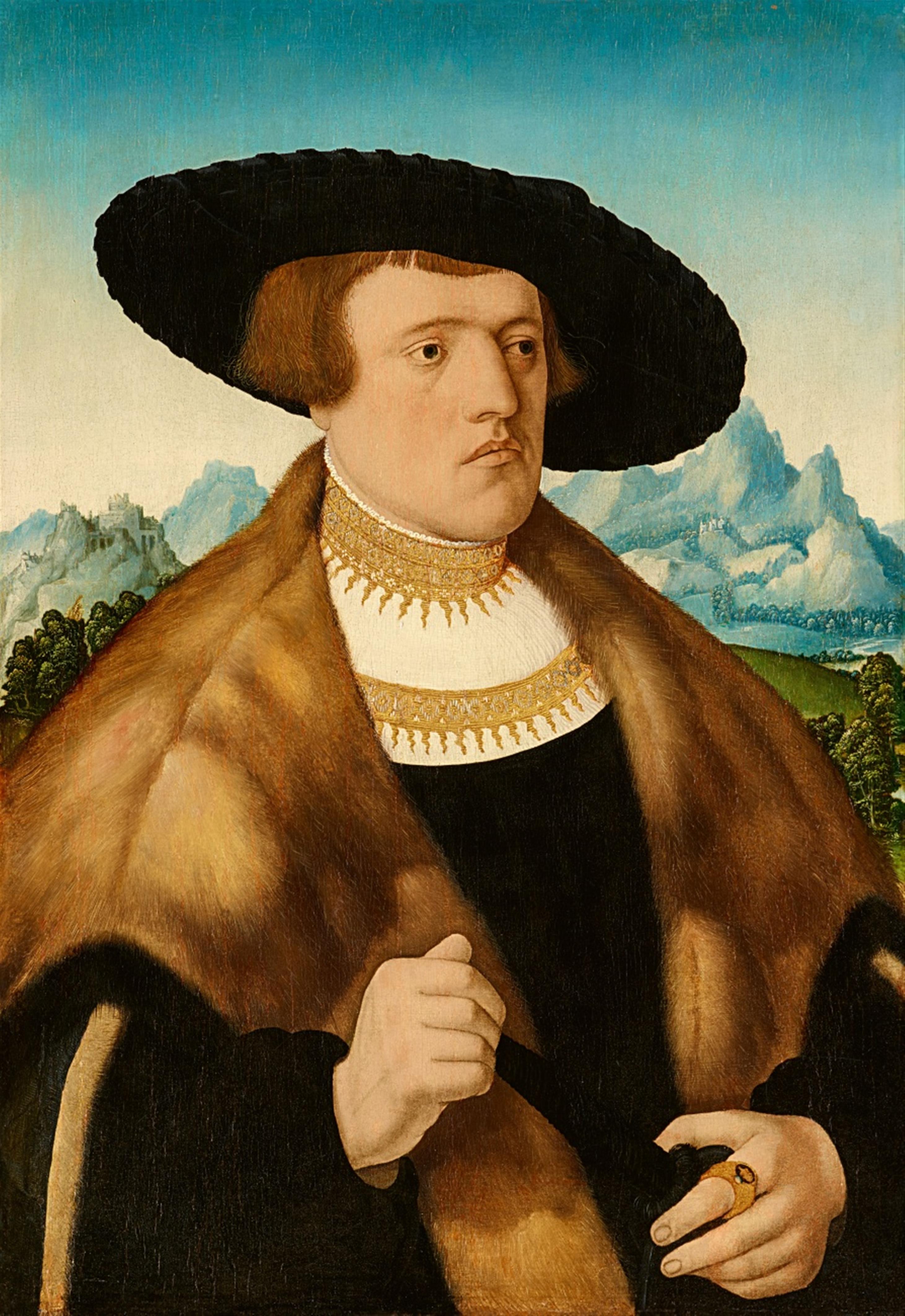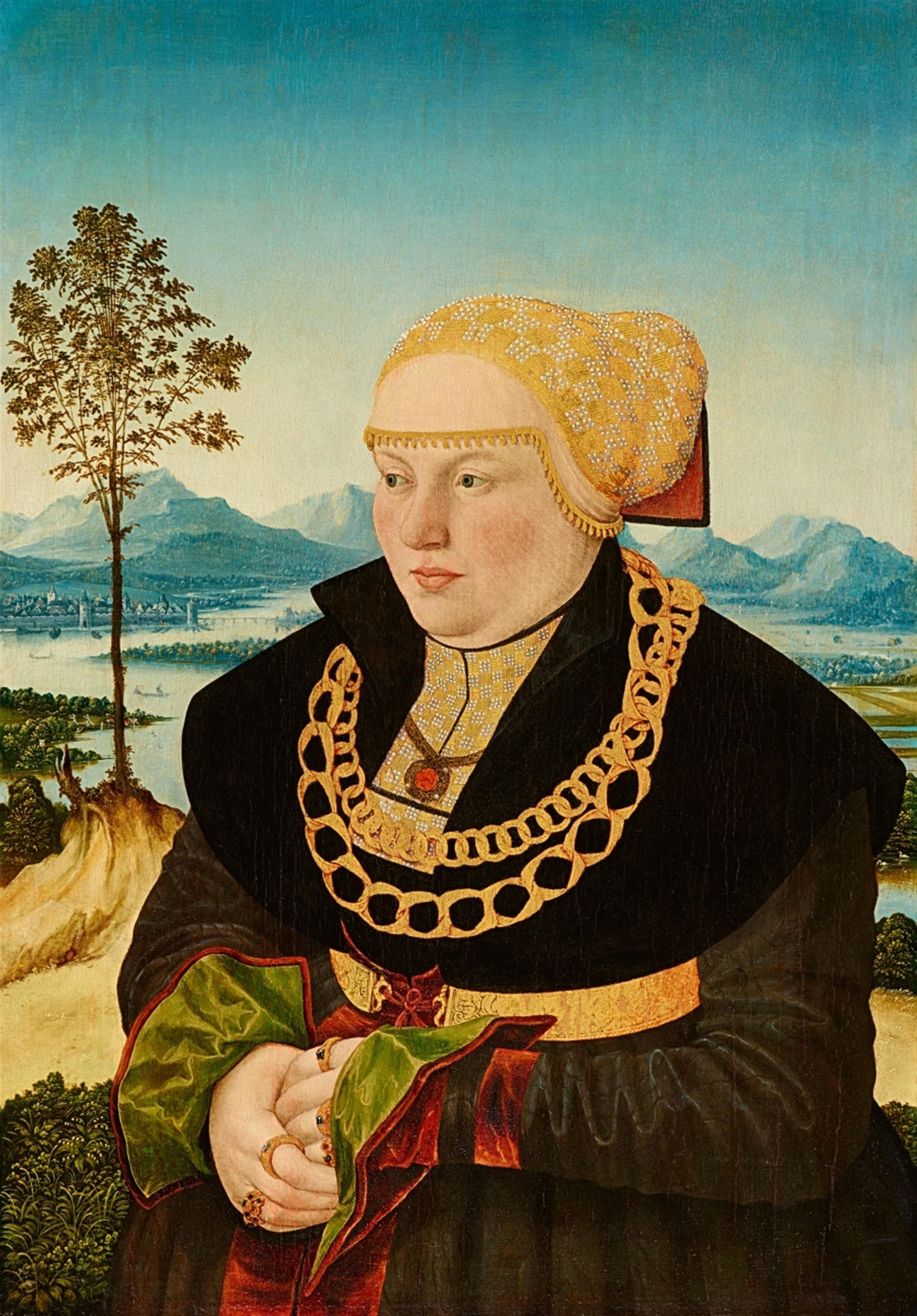Conrad Faber von Kreuznach
Portrait of Johann Raiss in Front of a Vast Landscape
Portrait of Anna Uffsteiner in Front of a Vast Landscape
Oil on panel (parquetted). 50 x 35.5 cm and 50.5 x 35 cm.
Shaped by the early portraits of Cranach and the Danube school, these representative half-figure portraits in front of vast landscapes fit perfectly into the impressive œuvre of Conrad Faber von Kreuznach. Probably born in Kreuznach, today Bad Kreuznach, on the river Nahe, the young painter can be traced to Frankfurt from 1524. In 1526 he worked there in the workshop of the painter Hans Fyoll, located in the Fahrgasse 102. Faber's portraits, consisting of over 40 works, serve as a mirror of Frankfurt High Society of that time depicting primarily members of the noble Frankfurt society, Alt-Limpurg, Frankfurt councillors and their wives. The couple Johann Raiss and Anna Uffsteiner also belonged to this prosperous and prestigious class. Raiss was a Frankfurt patriciate and, like his father before him, a city councillor, whilst his elder brother Weicker held the office of mayor several times. As early as 1529, Faber painted the brothers alongside their sister Christina. One year later, Johann married the widow Anna Uffsteiner, also from a respected family. In the portrait, Raiss is clothed in the typical apparel of the Frankfurt patriciate of his time: a black doublet, the wide neckline revealing the magnificent gold embroidery on the collar and yoke. Over this he wears a wide, red-brown fur overcoat. The distinctive black beret gives the portrait a particularly striking silhouette, contrasting strongly against the delicate green-blue landscape in the background. His left hand, adorned with a signet ring, grasps the handle of his sword. Anna Uffsteiner also wears the characteristic dress of Frankfurt patricians of the second quarter of the 16th century. The gold embroidered bonnet, also called a calotte, a brocade belt, rings and gold chains are also signs of their wealth. Her anthracite-coloured dress with a wide, dark collar is adorned with magnificent velvet red and green cuffs. The rather fleshy but powdery, smooth carnations are typical of portraits by Faber von Kreuznach.
When the painting was parqueted, the coats-of-arms of the Raiss and Uffsteiner families on the reverse were removed by the smooth planing of the panels. Photographs of the coat-of-arms have however been preserved (see ill.). Above the arms were the inscriptions: “JOHANN REYS SEINES ALTRS XXX 1533” and “ANNA UFSTENDERI WAS ALT XXXII MDXXXIII”.
Works by Conrad Faber von Kreuznach are to be found in many large collections such as the Städel Museum in Frankfurt, the Art Institute of Chicago and the National Gallery of Ireland in Dublin. His best known work is probably the double portrait of Justinian and Anna von Holzhausen from 1536 (Städel Museum, Frankfurt), showing the couple in an architectural setting before a wide landscape. A winged cupid is seated on a stone console between them with an arrow and a bunch of grapes, conjuring up the idea of sensual love as the foundation for marriage. There is no question that this representation, unique in painting north of the Alps, is a very frank statement about love.
Faber von Kreuznach holds an important place in art history not only as a portrait painter, but also as a cartographer. In 1552, he drew the Frankfurt settlement plan, the first topographically exact view of the city, which can be found today in the form of a woodcut in the Historisches Museum in Frankfurt. Despite his frequent commissions for Frankfurt patricians, Faber died in the spring of 1553 deep in debt and impoverished as a result of an unfortunate guarantee, in his adopted city of Frankfurt.
Provenance
With Colnaghi, London, 1913;
With Knoedler Gallery, New York, 1913;
Mrs W. Hayward (later Mrs Morton, later Mrs Rovenski);
Her sale, Parke-Bernet, New York, 1957;
William A. Graham, Baltimore, Maryland, 1963;
Anonymous sale, Sotheby's, New York, 1979.
Literature
Max J. Friedländer: Conrad Faber. Painter of the Patricians of Francfort in the Second Quarter of the XVIth Century, in: Art in America, I (1913), pp. 143ff, nos. 11 & 12, reproduced figs. 5 & 6;
Erna Auerbach: Faber von Creuznach, or the Master of the Holzhausen Portraits, in: The Burlington Magazine, LXX (1937), pp. 15-24, reproduced plate IIID;
Wolfgang Brücker: Conrad Faber von Creuznach, in: Schriften des Historischen Museums Frankfurt a.M., XI (1963), pp. 45-6, 175-6, nos. 20 & 21, 68 & 69;
Angelica Dülberg: Privatportraits. Geschichte und Ikonologie einer Gattung im 15. und 16. Jahrhundert, Diss., Cologne 1985, published Berlin 1990, p. 194, nos. 58 & 59, reproduced pp. 526-9;
Corinna Peuckert, in Ekkehard Mai (ed.): Das Kabinett des Sammlers, Cologne 1993, pp. 16-19, nos. 7 & 8, reproduced.




